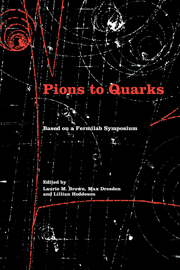Book contents
- Frontmatter
- Contents
- List of contributors
- Foreword by Leon M. Lederman
- Editors' acknowledgments
- Photographs of the symposium
- List of abbreviations
- List of notation
- I Introduction
- II Particle discoveries in cosmic rays
- III High-energy nuclear physics
- IV The new laboratory
- 9 The making of an accelerator physicist
- 10 Accelerator design and construction in the 1950s
- 11 Early history of the Cosmotron and AGS at Brookhaven
- 12 Panel on accelerators and detectors in the 1950s
- 13 Accelerators and the Midwestern Universities Research Association in the 1950s
- 14 Bubbles, sparks, and the postwar laboratory
- 15 Development of the discharge (spark) chamber in Japan in the 1950s
- 16 Early work at the Bevatron: a personal account
- 17 The discovery of the antiproton
- 18 On the antiproton discovery
- V The strange particles
- VI Weak interactions
- VII Weak interactions and parity nonconservation
- VIII The particle physics community
- IX Theories of hadrons
- X Personal overviews
- Name index
- Subject index
14 - Bubbles, sparks, and the postwar laboratory
Published online by Cambridge University Press: 07 May 2010
- Frontmatter
- Contents
- List of contributors
- Foreword by Leon M. Lederman
- Editors' acknowledgments
- Photographs of the symposium
- List of abbreviations
- List of notation
- I Introduction
- II Particle discoveries in cosmic rays
- III High-energy nuclear physics
- IV The new laboratory
- 9 The making of an accelerator physicist
- 10 Accelerator design and construction in the 1950s
- 11 Early history of the Cosmotron and AGS at Brookhaven
- 12 Panel on accelerators and detectors in the 1950s
- 13 Accelerators and the Midwestern Universities Research Association in the 1950s
- 14 Bubbles, sparks, and the postwar laboratory
- 15 Development of the discharge (spark) chamber in Japan in the 1950s
- 16 Early work at the Bevatron: a personal account
- 17 The discovery of the antiproton
- 18 On the antiproton discovery
- V The strange particles
- VI Weak interactions
- VII Weak interactions and parity nonconservation
- VIII The particle physics community
- IX Theories of hadrons
- X Personal overviews
- Name index
- Subject index
Summary
Instruments and history
When we think about the history of physics, we usually think about theories – the magisterial sweep of relativity, quantum mechanics, current algebra, SU(3), and gauge theories seems to subsume and dwarf the details of experiments. And if experiments appear small, how much less significant are instruments? The great breaks and continuities of physics are typically defined by the epochal accomplishments of Maxwell's equations, Einstein's special relativity, nonrelativistic quantum mechanics, and quantum electrodynamics. Such a “theorocentric” view has become ingrained in our pedagogical, physical, and historical literature. Most textbooks attach only a passing section on the devices of experimentation. The subfields of physics are classified by the theories they lead to – not by all the results one can get from instruments.
But it is hopelessly one-sided to let theory stand in for all of physics when we want to understand the past sympathetically, to capture the felt continuities of physicists in the day-to-day practice of their discipline. Experimentalists frequently move between theoretical areas linked only by a continuity in the experimental skills and instruments they have at hand. Here I want to examine some of the “instrumental” continuities – and discontinuities – that existed in the 1950s, for that decade saw a proliferation of instruments unparalleled in the twentieth century. Necessarily, only a few can be discussed here, as it is hardly possible to cover the multitude of detectors that arose in that decisive decade. Regrettably, I shall not discuss developments in nuclear emulsions or scintillators.
- Type
- Chapter
- Information
- Pions to QuarksParticle Physics in the 1950s, pp. 213 - 251Publisher: Cambridge University PressPrint publication year: 1989
- 2
- Cited by



